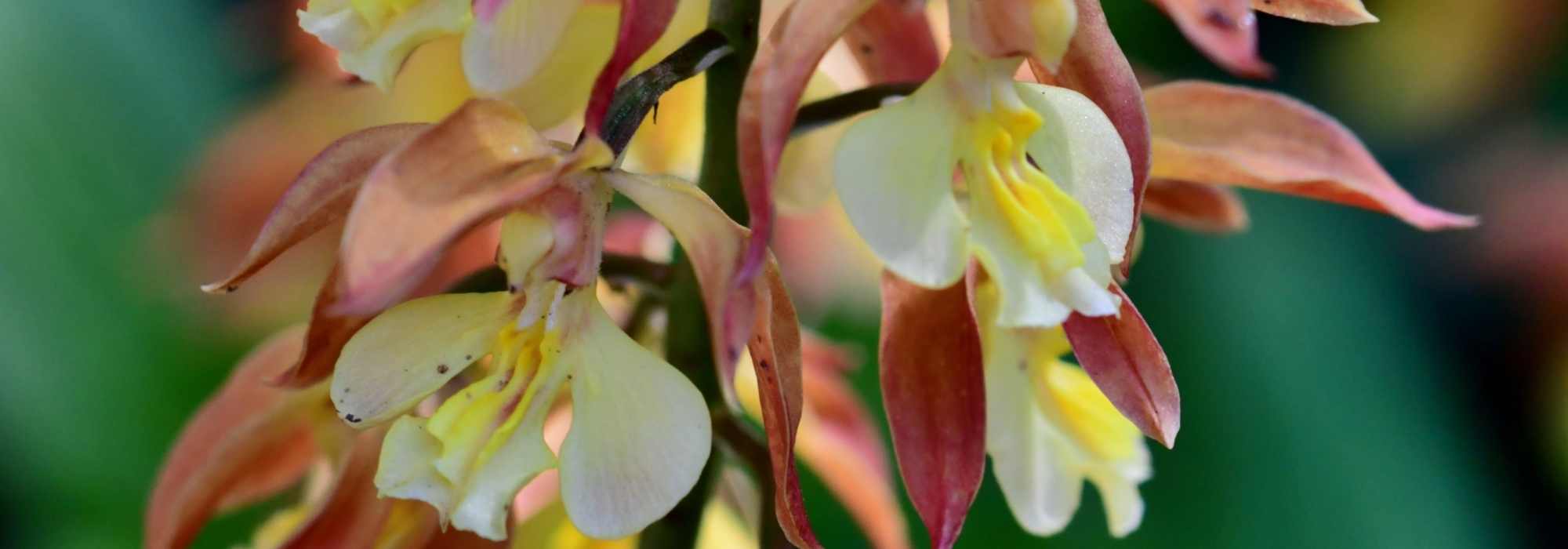
Calanthe: planting and growing
Contents
Calanthe in a nutshell
- The genus Calanthe includes mostly terrestrial orchids
- Most of these orchids are tropical, but a few can be grown in the garden
- Hardy calanthes thrive in partial shade in rich, cool soil
- Their flowers last a long time and are often fragrant
- Easy to cultivate, calanthes are recommended for beginner orchid enthusiasts
The word from our expert
Calanthes are orchids that are as little known as they are easy to grow. Indeed, they are often recommended for beginners looking to start cultivating orchids. But beware! There are calanthes… and calanthes. Some should only be grown indoors or in a greenhouse, while others are sufficiently hardy to be introduced into our gardens as perennials: Calanthe discolor, Calanthe tricarinata, or Calanthe sieboldii, for example.
Although highly sought after in the UK, they are rarely found at our nurseries. Let’s hope this changes soon, as they are stunning shade orchids that create a carpet effect or can be combined with other shade perennials. Among the hardy calanthes, the foliage is evergreen or semi-evergreen, and flowering occurs between spring and summer (depending on the species).
These terrestrial orchids require nothing more than a semi-shaded position, fresh but well-drained soil, and humus-bearing earth. In short, a woodland corner in your garden will do perfectly. They can even be grown in pots or containers.
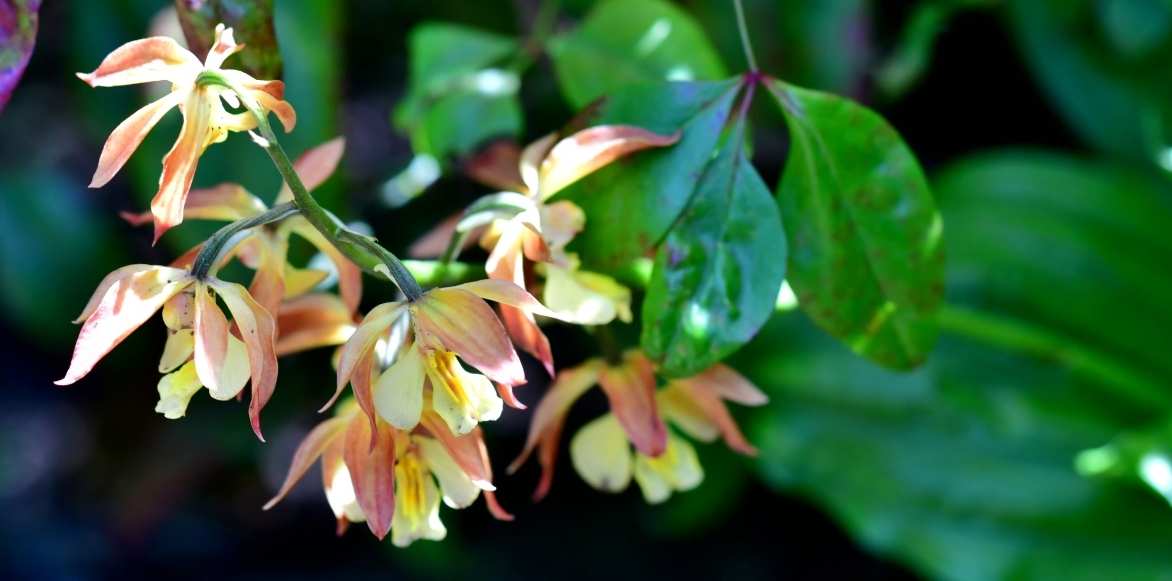
Calanthe discolor
Botany and description
“`html
Botanical data
- Latin name Calanthe sp.
- Family Orchidaceae
- Common name Calanthe
- Flowering April to June, sometimes later (depending on species)
- Height 40 to 80 cm
- Sun exposure partial shade to shade
- Soil type rich and humus-bearing, remaining cool but well-drained
- Hardiness from -10°C to -15°C (for hardy calanthes)
Calanthes belong to the Orchidaceae family. The genus Calanthe comprises around 180 species distributed across Asia (China, Japan, Korea…), Oceania, Africa, and Central America. Most species are of tropical origin and can be cultivated indoors or in a warm greenhouse. They do not tolerate temperatures below 10°C. Notable species include: Calanthe calanthoides, Calanthe sylvatica, Calanthe corymbosa or Calanthe delphinoides… Some of these orchids are semi-hardy and can be grown in pots in a temperate greenhouse, such as Calanthe vestita.
In contrast, some species are hardy enough to be acclimatised in our gardens. They thrive in their natural habitat in subtropical forests, sometimes at altitude. This includes species such as: Calanthe triplicata, Calanthe aristulifera, Calanthe tricarinata, Calanthe discolor, Calanthe masuca, Calanthe rosea, Calanthe nipponica, Calanthe okinawensis, Calanthe reflexa and Calanthe sieboldii. The easiest to acclimatise outdoors in our latitudes are Calanthe discolor and Calanthe tricarinata.
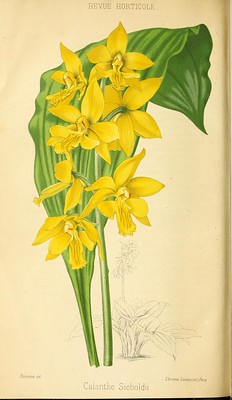
Calanthe sieboldii, botanical illustration
Most orchids of the genus Calanthe are termed “terrestrial”, meaning they grow on the ground, in soil. However, a few tropical species are epiphytic (growing without substrate, typically on the bark of a tree) and lithophytic (growing directly on rock). Hardy calanthes are all terrestrial.
Terrestrial calanthes possess either a fleshy pseudobulb in the case of non-hardy calanthes, or a spreading root system at the surface for hardy calanthes. All these orchids exhibit a sympodial growth habit (in clumps). They produce one or more new shoots each year.
The plant is monocotyledonous. The foliage is deciduous or evergreen depending on the species: non-hardy calanthes are deciduous, while hardy calanthes generally have evergreen (or semi-evergreen in severe cold) foliage. The leaves are typically large, thin, and slightly plicate. Notably, Calanthe argenteostriata has very attractive silver-striped green evergreen foliage.
Flowering is either spring for the hardy species or autumn for the non-hardy ones. It lasts from two to four weeks, sometimes longer. The flowers are arranged in long spikes with several grouped flowers: yellow, white, or pink. The flowers, borne in the axil of persistent bracts, are typical of orchids: bilateral symmetry, 5 petals and 5 sepals arranged above and on the sides, and a lip below. A nectariferous spur is present. Calanthe flowers are often fragrant. Cross fertilization is ensured by pollinators, but some cases of asexual fertilization are possible. Additionally, some calanthes with a pseudobulb can produce mini-seedlings at their apex without fertilization.
The fruits are pods containing a multitude of very fine seeds. Like most orchids, they require a symbiotic association with a specific fungus to germinate (the species of fungus depends on the species of orchid).
Nota bene: Please ensure to purchase only certified plants, cultivated. Let us avoid plundering Nature, which is already fragile, for our gardens…

Calanthe discolor, Calanthe tricarinata (© HQ), Calanthe triplicata (© Kuo Chu Yueh)
“`
The most beautiful species to grow in the garden
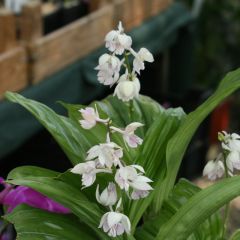
Calanthe aristulifera - Garden orchid
- Flowering time May, June
- Height at maturity 30 cm
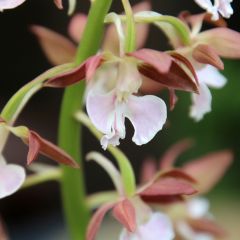
Calanthe discolor - Garden orchid
- Flowering time June, July
- Height at maturity 40 cm
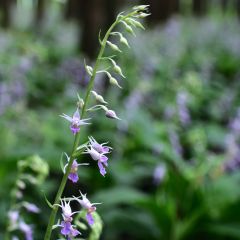
Calanthe reflexa - Garden orchid
- Flowering time August, September
- Height at maturity 40 cm
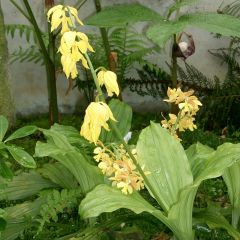
Calanthe sieboldii - Garden orchid
- Flowering time June, July
- Height at maturity 40 cm
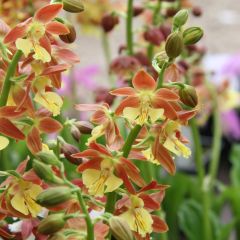
Calanthe tricarinata - Garden orchid
- Flowering time June
- Height at maturity 60 cm
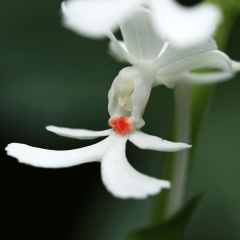
Calanthe triplicata - Garden orchid
- Flowering time August, September
- Height at maturity 80 cm
Discover other Calanthe
View all →Available in 0 sizes
Available in 2 sizes
Available in 2 sizes
Available in 1 sizes
Available in 1 sizes
Available in 1 sizes
Available in 1 sizes
Available in 1 sizes
Available in 1 sizes
Planting Calanthe
Non-hardy calanthes, originating from tropical regions, should only be grown in pots under glass or indoors. Their ease of cultivation comes from the fact that these orchids can thrive in a substrate resembling soil. A simple “potting mix” will suffice.
However, we will focus here on calanthes suitable for outdoor cultivation in the garden: hardy or semi-hardy calanthes. These are calanthes with evergreen or semi-evergreen foliage that bloom in spring.
Where to plant a calanthe?
In partial shade or even in full shade, under the canopy of deciduous trees.
The soil should be rich and humus-bearing, neutral to acidic. It must remain cool throughout the season, never dry in summer, but not waterlogged in winter, so it should be well-drained.
In other words, calanthes require a forest-like atmosphere similar to their natural habitat.
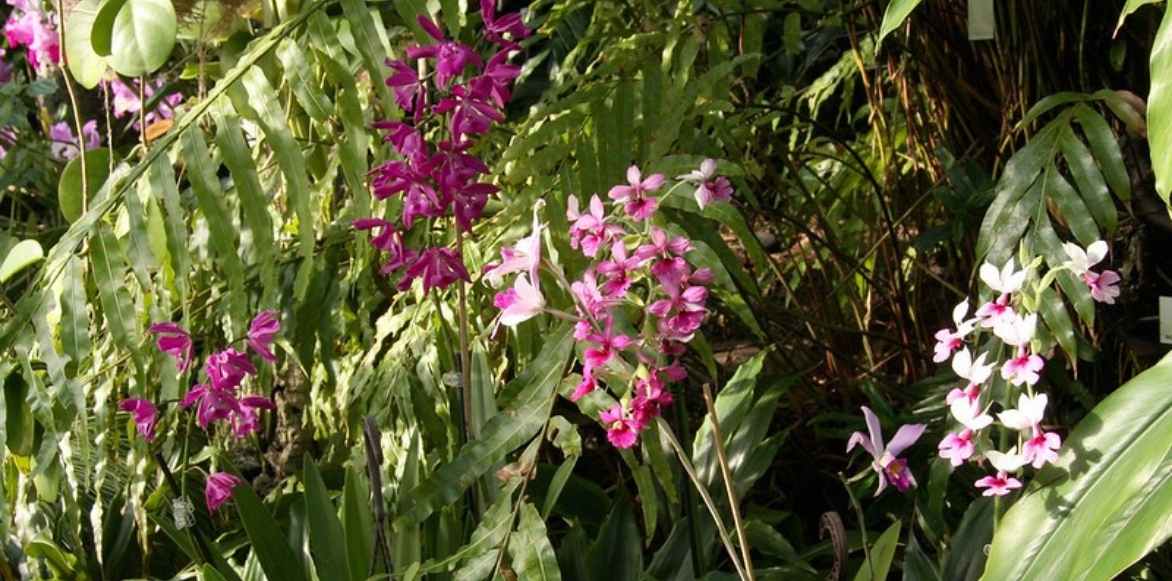
Calanthes (© Maja Dumat)
When to plant a calanthe?
Planting should be done in spring: between April and May.
How to plant calanthes?
In the ground
A calanthe is planted like any other perennial.
- Dig a hole twice as wide and deep as the root ball;
- Loosen the bottom of the hole well;
- If your soil is too heavy (clay soil): you can add potting mix, compost, or even mix small gravel with the soil to improve drainage. A raised planting may also be considered;
- Place the root ball of your calanthe at the bottom of the hole and then backfill with the excavated soil;
- Water thoroughly with a good watering can of room temperature water to avoid “air pockets” between the soil and the roots;
- Calanthes are quite nutrient-hungry orchids: adding crushed horn, dried blood, or dehydrated manure at planting will be beneficial;
- If your winters are particularly cold (-15 °C for several days), you can provide preventive protection with a good layer of fallen leaves (20 cm) or mulch (10 cm).
In a pot or container
Calanthes can be grown in pots or containers if they are sufficiently shaded.
- In a pot or container with drainage holes (very important!), place a good layer of clay balls or, if not available, gravel at the bottom;
- Fill the volume with a substrate: 40% heather soil (for acidity) and 60% good horticultural potting mix.
- Plant your calanthes and water well;
- Terrestrial calanthes are quite nutrient-hungry, applying a geranium-type fertiliser at half strength every week from mid-May to mid-September will be beneficial.
Do not forget to water during the growing season; do not let the substrate dry out!
Cultivation and care of calanthes
Although evergreen, the foliage of hardy calanthes can be cut back to a few centimetres from the stump.
A thick mulch can be applied in winter to protect the plant from the cold: dead leaves, branch chippings, straw…
Diseases and potential pests
Only slugs (and possibly snails) can attack calanthes. Aside from that, if you provide your orchids with the right growing conditions, you will encounter no issues.
Please note: scale insects can attack non-hardy calanthes grown in greenhouses or indoors.
Multiplying Calanthe
Multiplication can be done by dividing the pseudo-bulb or by cutting the offsets from the clump in spring (April). You can then place the offsets or mini pseudo-bulbs in pots with well-draining substrate (such as sowing compost). Water moderately until roots appear, then increase watering. Planting in open ground can be considered the following spring.
Otherwise, let nature take its course! The stumps of certain calanthes are “rootstock” (we put this word in quotes, as it is not really the exact term). This is the case, for example, with Calanthe discolor, one of the easiest to grow and find commercially. The “rootstock” will spread over the years and give rise to new clumps of calanthes, gradually forming a carpet of orchids.
How to pair your calanthes?
Calanthes are woodland plants. How about adopting a Calanthe discolor, one of the easiest to acclimatise? It is an Asian orchid, so it would be nice to pair it with companions from the same part of the globe (or thereabouts…).
To enhance this Asian woodland atmosphere, let’s add some Asian ferns: like this stunning Athyrium nipponicum var. pictum ‘Red Beauty’, a Japanese fern with deciduous green-silver fronds, tinged with burgundy; and why not include some bamboo ferns, Coniogramma emeiensis, with their exotic appearance.
As we are under the shade of large trees, we need to brighten up this darkness with silver touches or some light colours: hostas are perfect for this! The ‘Hosta ‘Fire & Ice’ is one of the brightest, thanks to its cream-white variegated foliage, but we can add some yellow touches with a few Hostas ‘Sunny Halcyon’.
Calanthes are botanical curiosities. What if we paired them with other botanical curiosities that require the same care: a Trillium sessile (an American perennial, but let’s be adventurous!) will start flowering just before Calanthe discolor, and a cobra plant, an Arisaema candidissimum, will continue to provide an inflorescence after the orchid. In short, weeks of atypical flowering…
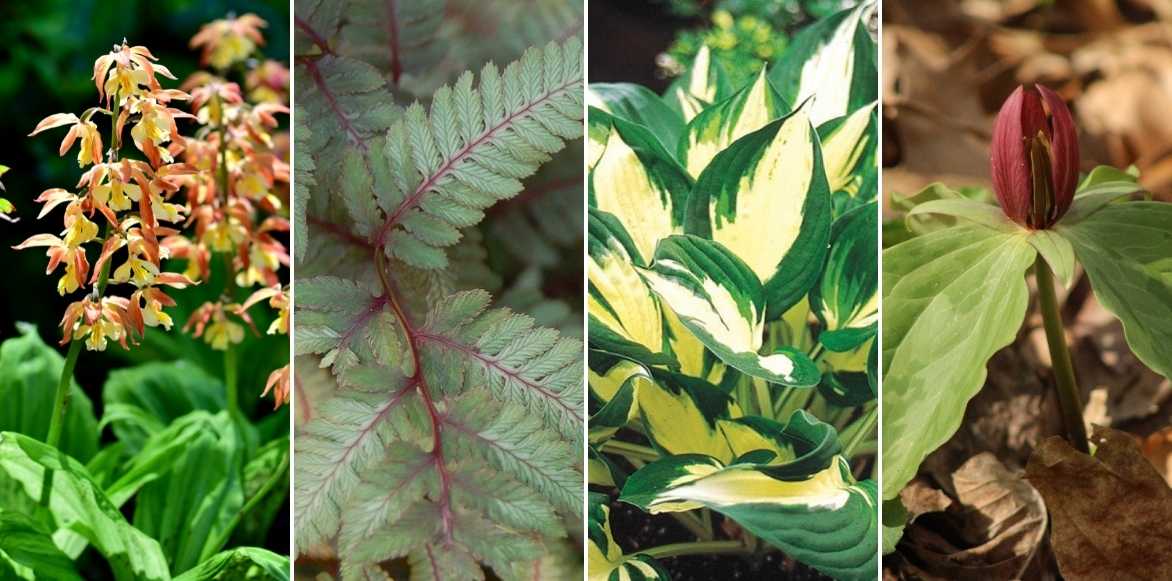
Calanthe tricolor, Athyrium niponicum var. pictum ‘Red Beauty’, Hosta ‘Fire and Ice’, and Trillium sessile
Did you know?
- Hardy calanthes are highly valued in the UK, but struggle to find their place in France and Belgium;
- To be precise, calanthes belong to a subfamily of orchids: the Epidendroideae;
- This subfamily is further divided into three categories: the section Preptanthe, which includes deciduous calanthes, the section Styloglossum with calanthes that have evergreen foliage but deciduous bracts, and the section Calanthe, stricto sensu, with calanthes that have both persistent foliage and bracts;
- The genus Calanthe was described in 1821 by Robert Brown, a Scottish botanist;
- The name “Calanthe” comes from Greek: from “Kalos”, meaning beautiful, and “Anthos”, meaning flower;
- Calanthe is the name of a character from the television series The Witcher, adapted from the novels “The Witcher”, written by Polish author Andrzej Sapkowski. This writer, as can be felt in the reading of his works, shares the same passion for botany as we do. So, coincidence? … Yes, probably.
Useful resources
→ Find all our calanthes in our online nursery.
Discover the hardy orchids to grow in the garden!
Feel free to check our comprehensive guides to grow Cypripediums, Bletillas, Pleiones, and Dactylorhiza.
- Subscribe!
- Contents































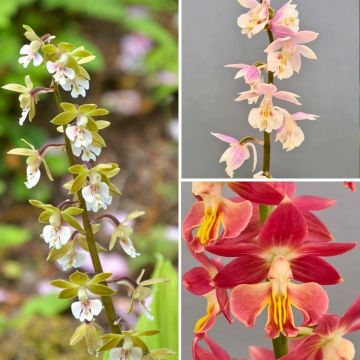



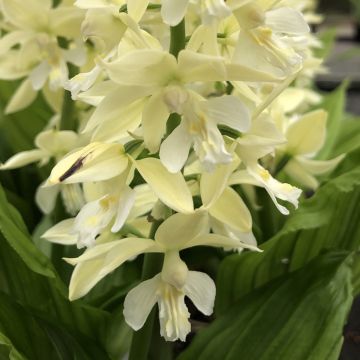
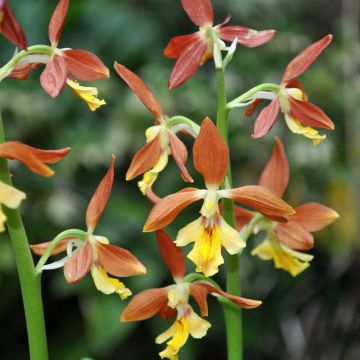
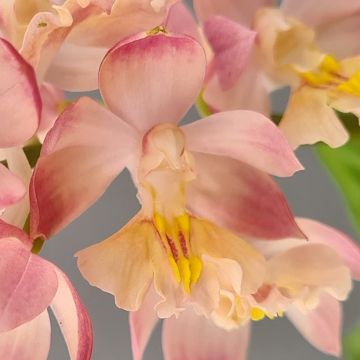
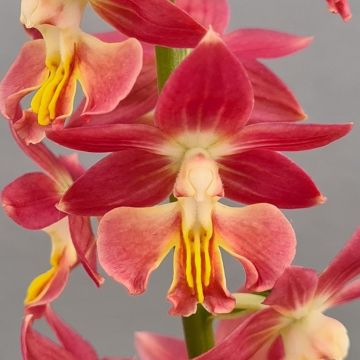
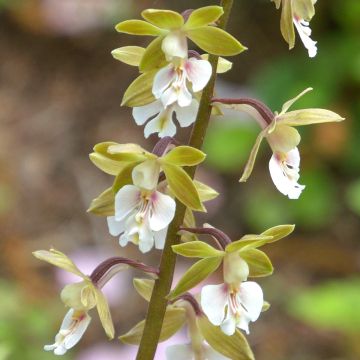
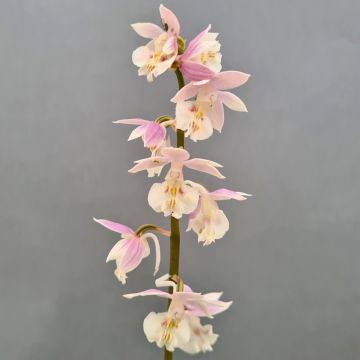
Comments